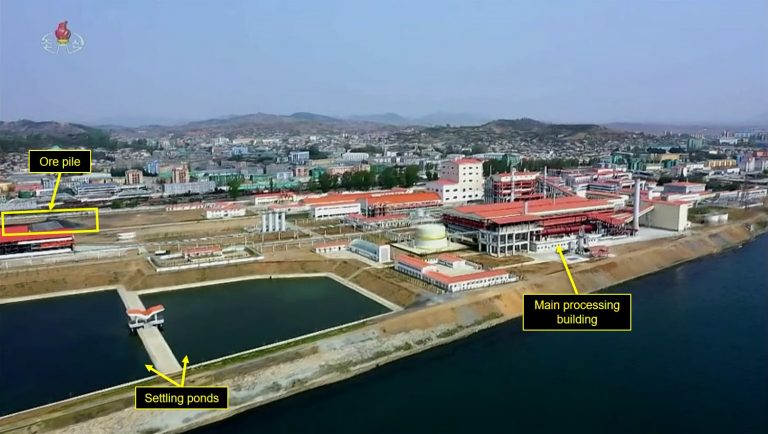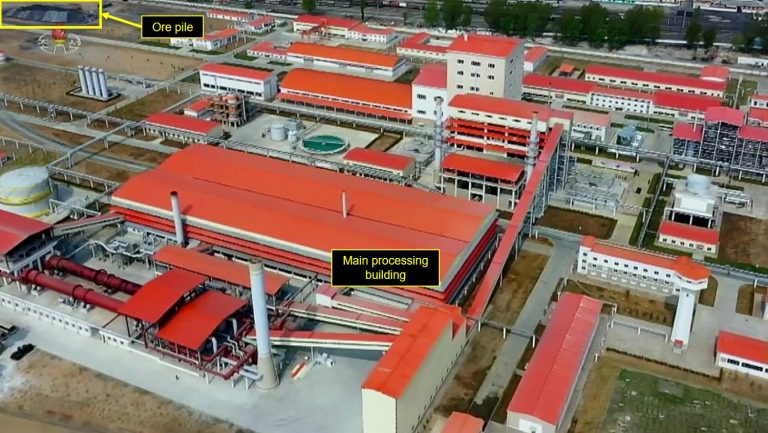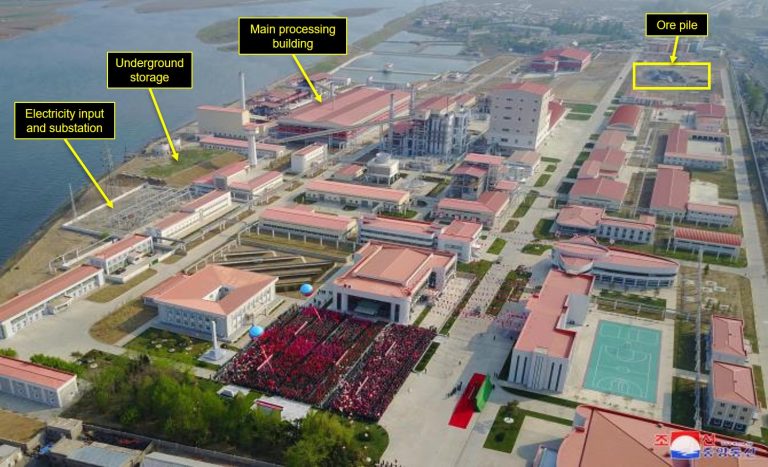The Sunchon Phosphatic Fertilizer Plant Is One Year Old, but Is It Operating?
May 1 marks the one-year anniversary of the opening of the Sunchon Phosphatic Fertilizer Factory.[1] The factory is an important piece in Kim Jong Un’s push to build up North Korea’s domestic chemical industry and fertilizer production, as part of larger efforts to increase agricultural production and save foreign currency. However, after 12 months, it remains unclear if the plant is fully operational. Commercial satellite imagery over the last year indicates a gradual increase of activity throughout the complex, but no major activity was observed, and no state industrial achievements for this site were reported. This suggests that production is likely still at an early stage.
Figure 1. Overview of the Sunchon Phosphatic Fertilizer Factory.
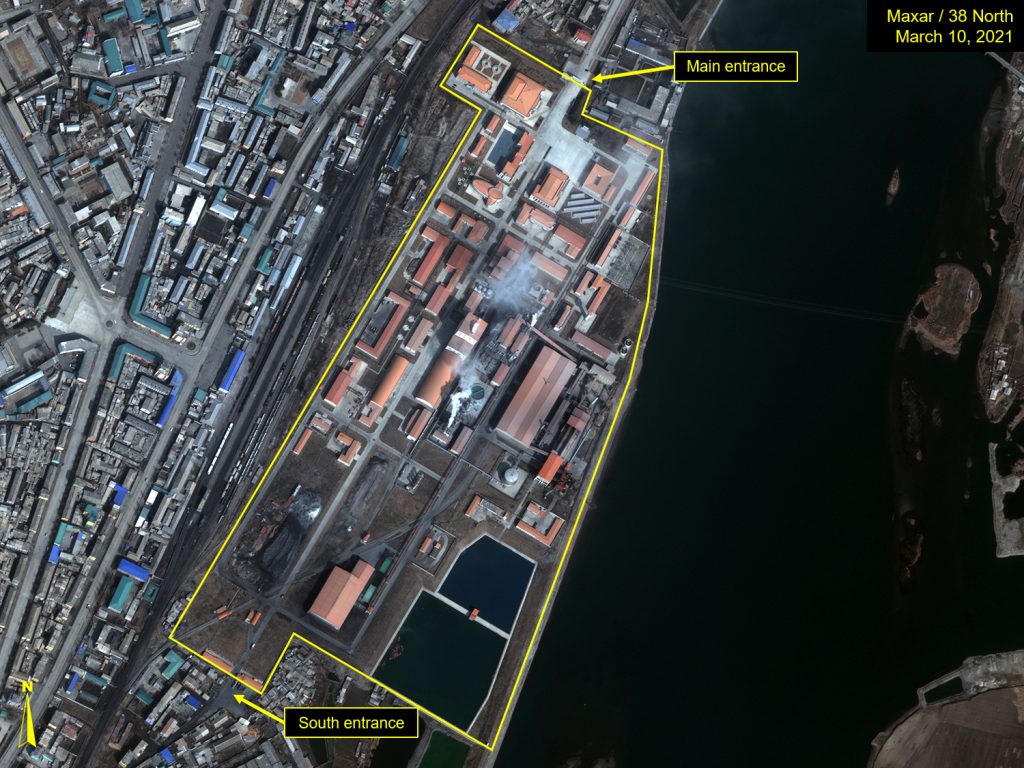
Background
The Sunchon Phosphatic Fertilizer Factory is one of several factories intended to develop a C1 chemical industry that Kim first called for in a speech at the Seventh Congress of the Workers’ Party of Korea in June 2016 and has reiterated in his new year’s addresses since then.[2] Its construction began in 2017 and was first reported in state media in February 2018.[3] Underlining its importance, the site received regular inspection visits throughout its construction from senior leaders, including Pak Pong Ju, Kim Jae Ryong and Choe Ryong Hae. Kim Jong Un visited the site twice last year; in January to inspect progress and again in May to inaugurate the plant.[4]
As North Korea is rich in coal, development of a C1 chemical industry could supply a large amount of raw materials to the economy, reduce dependence on imports of oil and fertilizers and save foreign currency.
The Sunchon area, located about 50 kilometers (km) from Pyongyang, is an ideal location for a fertilizer factory. Large limestone mines are located nearby, rich in calcium carbonate and anthracite coal, in addition to apatite mines, which provide material for phosphatic fertilizer production.
The large fertilizer complex includes facilities for both wet and dry process fertilizer production, along with other manufacturing activities and research and development.[5]
Figure 2. Overview of major industrial facilities in the Sunchon area.
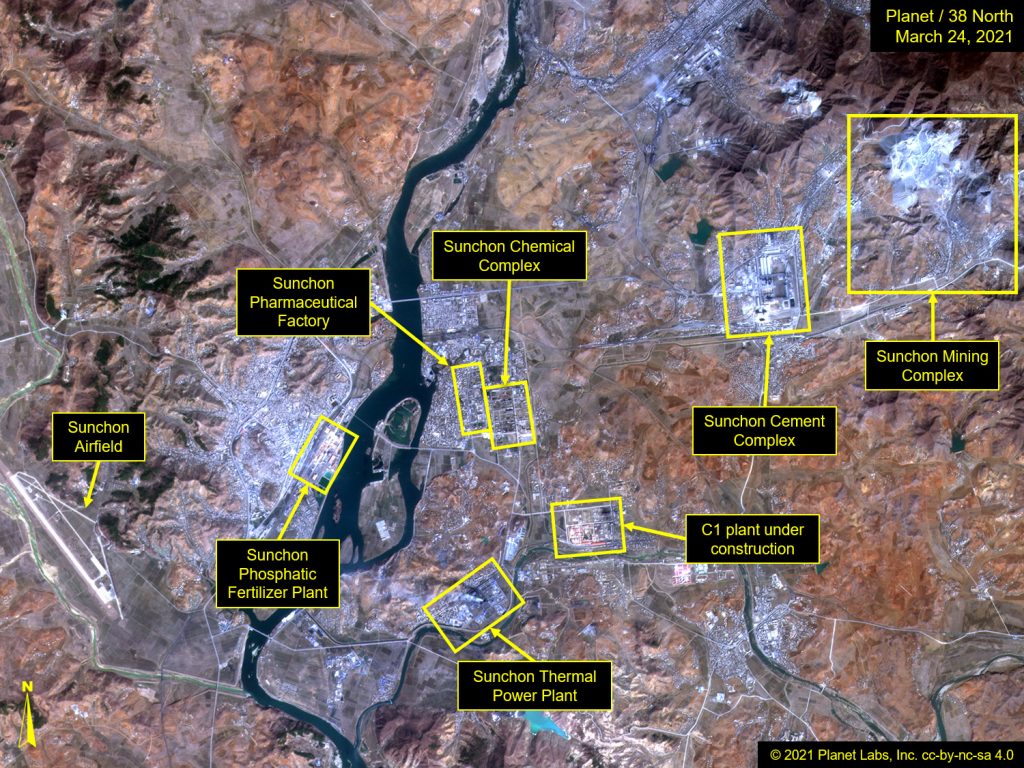
Raw Materials Arrive
Raw material was first observed at the site in mid-March 2020, when an ore pile began building in an open area at the southern end of the factory. It was visible in the background of some Korean Central Television coverage of the plant opening in May 2020.
Figure 3. An ore pile is visible in state media video and photographs released shortly after the opening in May 2020.
Note: Hover over slideshow and click on left/right arrows to navigate.
The pile, which is dark in color and could be coal or coke, has continued to grow ever since. In November 2020, a new pile of materials appeared in an adjacent storage area. Its color and location suggest it is not coal but another raw material for the plant, possibly crushed limestone or apatite.
Two buildings at the plant are directly linked to North Korea’s railway network via a rail spur along the Phyongra Line. The same line also connects to the Sunchon Cement Complex, although tire tracks visible in satellite imagery suggest ore for both piles is delivered by truck.
Figure 4. Rail access to the factory from a spur off the Phyongra rail line.
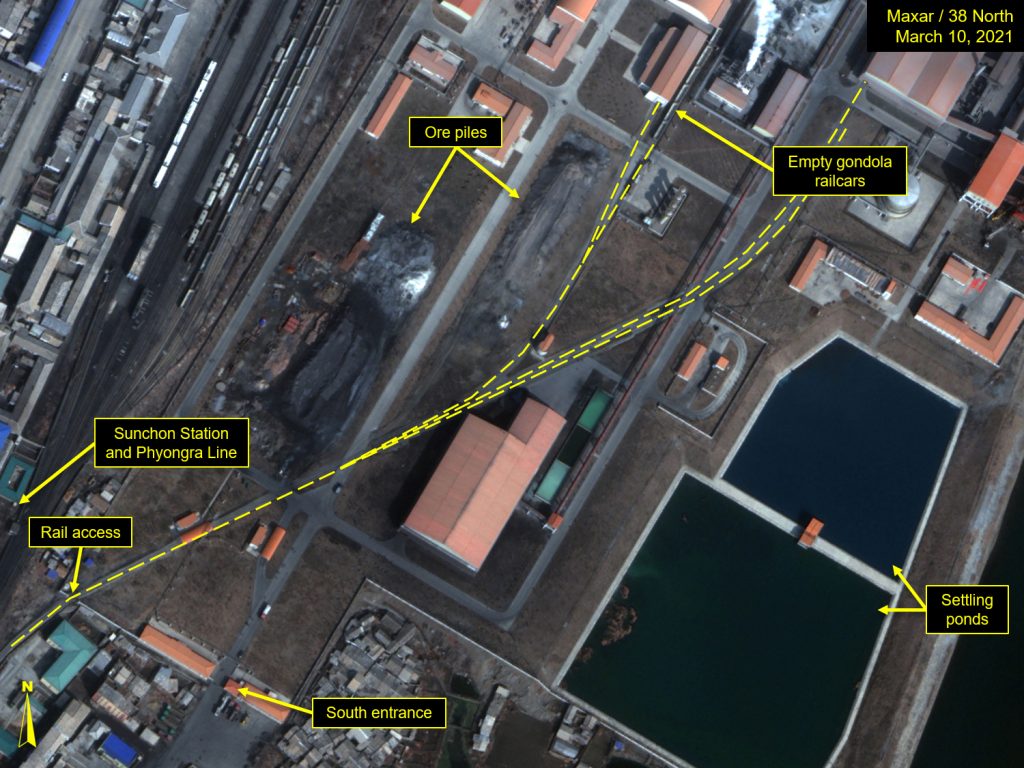
Throughout the summer of 2020, railcars were observed on multiple days. In many instances, tank cars were visible, possibly carrying sulfuric acid or molten sulfur, which are also used in production.
In September 2020, three rail cars were seen with three spherical containers on each. The shape suggests they could contain pressurized gas.
Signs of Fertilizer Production
In October 2020, smoke was observed for the first time from stacks at both the main production building and one other building.
Around the same time, a slight change in color was seen for the first time in the two settling ponds. The ponds are used to separate minerals from a slurry that is used in the wet production process.
The color change was likely caused by the separation of large and fine sediment in each pond. In December 2020 and February 2021, the smaller of the two ponds remained ice-free while the larger was iced over. This indicates the fresh slurry flows first into the smaller pond then into the larger one.
Figure 5. Smoke rising from three stacks at Sunchon Phosphatic Fertilizer Factory.
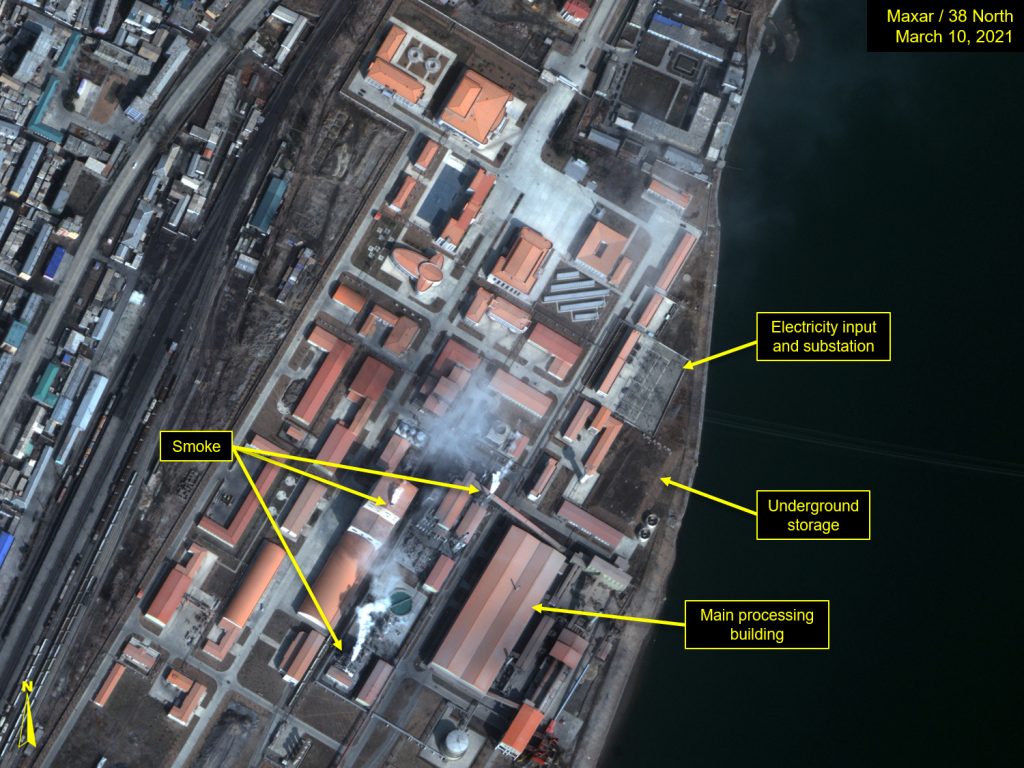
Although there are some signs of plant activity, such as deliveries of raw materials and smoke emissions from the stacks, the plant does not yet appear particularly active. A few personnel and vehicles can be observed in images but nothing near the level of activity at the nearby well-established Sunchon Cement Factory, where multiple trucks are often seen queuing to carry cement from the plant.
Perhaps more tellingly, state media has yet to report on any progress in production at the factory. During the “80-day campaign” at the end of 2020 and in the three months since the Party Congress in January, North Korean media has relayed almost daily reports of workplaces beating production targets.
The Sunchon Cement Complex is 10 percent ahead of target, the Sunchon Thermal Power Plant is increasing efficiency and the Sunchon Limestone Mine is blasting thousands of cubic meters of limestone to increase production, but the fertilizer factory has not been mentioned at all.[6] However, achievements of other fertilizer factories have been repeatedly stated.
The absence of such a key factory in state reporting of industrial achievements may indicate that the facility is not fully operational—it is not unusual for this kind of facility to be started up gradually. However, it could also mean that the plant has experienced problems starting up, such as a lack of key equipment or difficulties with the coal gasification processes.
- [1]
“Supreme Leader Kim Jong Un Cuts Tape for Completion of Sunchon Phosphatic Fertilizer Factory,” KCNA, May 2, 2020.
- [2]
C1 chemistry refers to the gasification of anthracite and brown coal to produce synthetic gas with carbon monoxide and hydrogen, which is then used to produce methanol, a precursor to organic compounds such as ethylene and propylene. These compounds are used to produce gasoline, plastics, synthetic fibers (vinalon), fertilizers, paints, pesticides and medicines. See also: “Supreme Leader Kim Jong Un’s Report to the Seventh Congress of the Workers’ Party of Korea on the Work of the Central Committee (Full Text),” KCNA, June 20, 2016.
- [3]
“Phosphate Fertilizer Factory under Construction,” KCNA, February 3, 2018.
- [4]
See: “Pak Pong Ju Inspects Various Units,” KCNA, February 3, 2020; “Kim Jae Ryong Inspects Various Fields of National Economy,” KCNA, February 16, 2020; “Choe Ryong Hae Inspects Sunchon Phosphatic Fertilizer Factory under Construction,” KCNA, February 5, 2020; “Supreme Leader Kim Jong Un Gives Field Guidance to Sunchon Phosphatic Fertilizer Factory under Construction,” KCNA, January 1, 2020; and “Chairman Kim Jong Un attends inaugural ceremony of Sunchon Phosphatic Fertilizer Factory,” KCNA, May 1, 2020.
- [5]
Fertilizer is produced through both dry and wet processes. The wet process involves separating phosphoric acid from crushed phosphate-rich rock (for example, apatite) using sulfuric acid, while the dry process involves feeding rock, coke and sand into a furnace and extracting phosphoric acid from the white phosphorus that emerges.
- [6]
Korean Central Broadcasting Station, March 21, 2021; Korean Central Television, March 12, 2021; and Korean Central Television, March 11, 2021.

